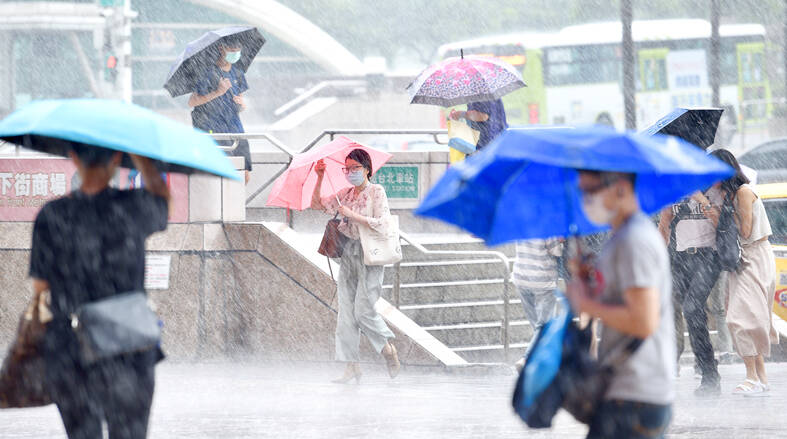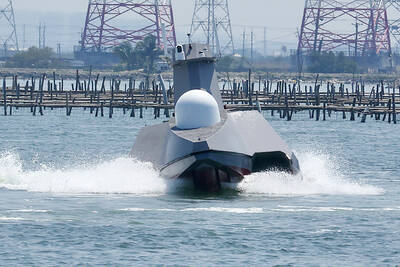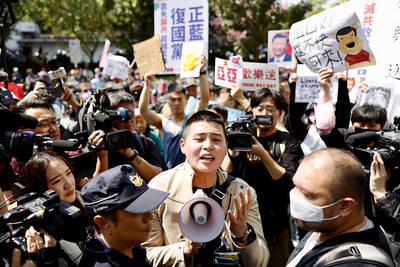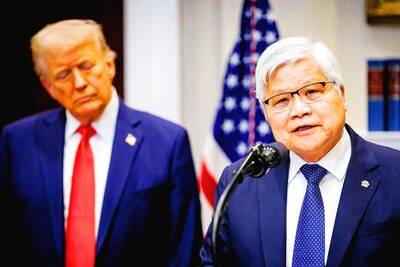The nation’s average temperatures have risen 1.5°C over the past century, a joint research project led by the Central Weather Administration (CWA) showed.
In the report to the legislature’s Transportation Committee yesterday, the CWA said extreme temperatures would become more common, with fewer spring showers.
Plum rains are expected to become more intense, it said, adding that there would be fewer typhoons affecting Taiwan, but those that do would be stronger and bring more rain.

Photo: Peter Lo, Taipei Times
The agency said it is still developing its next-generation severe weather monitoring system to improve predictions.
The Water Resources Agency (WRA) is also developing a drought warning system that has monitoring stations across the country with a resolution of 1km, it said, adding it would be able to provide drought forecasts one to three months in advance.
There would be new shoreline wind forecasts this typhoon season to assist local governments in deciding when to cancel work and school, the CWA said.
Severe rain forecasts are updated every three hours, and a warning system is also in place to send notifications when flash flooding is likely in mountainous regions, it said.
In related news, the WRA said that a weather front brought 19.08 million cubic meters of precipitation to reservoirs across the nation over the past three days, mainly in northern Taiwan.
From 7am on Friday to 7am yesterday, Sinshan (新山水庫), Shihmen (石門水庫), Feitsui (翡翠水庫) and Baoshan Second (寶二水庫) reservoirs, and Yuanshan Weir (鳶山堰) in the north collected 9.9 million cubic meters of rainwater, with Feitsui Reservoir receiving the most at 3.9 million cubic meters, WRA data showed.
Sinshan was at 92.7 percent capacity yesterday morning, Feitsui was at 75.4 percent, Shihmen was at 28.3 percent and Baoshan Second was at 36.9 percent.
In central Taiwan, Yongheshan (永和山水庫), Mingde (明德水庫), Liyutan (鯉魚潭水庫), Deji (德基水庫), Hushan (湖山水庫), Sun Moon Lake (日月潭水庫) and Wushe (霧社水庫) reservoirs received 8.6 million cubic meters of rainwater, with Deji Reservoir collecting the most at 2.8 million cubic meters.
As of yesterday morning, the Liyutan, Deji and Sun Moon Lake reservoirs were at 33.6 percent, 55 percent and 73.5 percent capacity respectively.
In the south, the Zengwen (曾文水庫), Wushantou (烏山頭水庫) and Nanhua (南化水庫) reservoirs received a total of 500,000 cubic meters of rainwater, and were at 79.1 percent, 43.3 percent and 37.5 percent capacity respectively.

ENDEAVOR MANTA: The ship is programmed to automatically return to its designated home port and would self-destruct if seized by another party The Endeavor Manta, Taiwan’s first military-specification uncrewed surface vehicle (USV) tailor-made to operate in the Taiwan Strait in a bid to bolster the nation’s asymmetric combat capabilities made its first appearance at Kaohsiung’s Singda Harbor yesterday. Taking inspiration from Ukraine’s navy, which is using USVs to force Russia’s Black Sea fleet to take shelter within its own ports, CSBC Taiwan (台灣國際造船) established a research and development unit on USVs last year, CSBC chairman Huang Cheng-hung (黃正弘) said. With the exception of the satellite guidance system and the outboard motors — which were purchased from foreign companies that were not affiliated with Chinese-funded

PERMIT REVOKED: The influencer at a news conference said the National Immigration Agency was infringing on human rights and persecuting Chinese spouses Chinese influencer “Yaya in Taiwan” (亞亞在台灣) yesterday evening voluntarily left Taiwan, despite saying yesterday morning that she had “no intention” of leaving after her residence permit was revoked over her comments on Taiwan being “unified” with China by military force. The Ministry of the Interior yesterday had said that it could forcibly deport the influencer at midnight, but was considering taking a more flexible approach and beginning procedures this morning. The influencer, whose given name is Liu Zhenya (劉振亞), departed on a 8:45pm flight from Taipei International Airport (Songshan airport) to Fuzhou, China. Liu held a news conference at the airport at 7pm,

KAOHSIUNG CEREMONY: The contract chipmaker is planning to build 5 fabs in the southern city to gradually expand its 2-nanometer chip capacity Taiwan Semiconductor Manufacturing Co (TSMC, 台積電), the world’s biggest contract chipmaker, yesterday confirmed that it plans to hold a ceremony on March 31 to unveil a capacity expansion plan for its most advanced 2-nanometer chips in Kaohsiung, demonstrating its commitment to further investment at home. The ceremony is to be hosted by TSMC cochief operating officer Y.P. Chyn (秦永沛). It did not disclose whether Premier Cho Jung-tai (卓榮泰) and high-ranking government officials would attend the ceremony. More details are to be released next week, it said. The chipmaker’s latest move came after its announcement earlier this month of an additional US$100 billion

Authorities yesterday elaborated on the rules governing Employment Gold Cards after a US cardholder was barred from entering Taiwan for six years after working without a permit during a 2023 visit. American YouTuber LeLe Farley was barred after already being approved for an Employment Gold Card, he said in a video published on his channel on Saturday. Farley, who has more than 420,000 subscribers on his YouTube channel, was approved for his Gold Card last month, but was told at a check-in counter at the Los Angeles International Airport that he could not enter Taiwan. That was because he previously participated in two